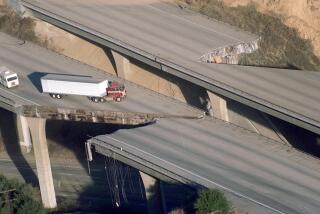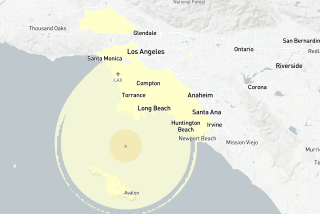6.9 Northern California quake a reminder of damaging 2010 temblor
In January 2010, a magnitude 6.5 earthquake rocked Eureka in Northern California, damaging homes, toppling chimneys and snapping power lines.
It struck 33 miles southwest of the coastal city of roughly 26,000, sending residents running into the streets, some fearing a tsunami.
After a magnitude 6.9 earthquake struck the region Monday, Sgt. Brian Stephens of the Eureka Police Department said with relief, “We have not had one report of damage anywhere in the city.”
“Definitely a change from the last one we had,” Stephens said, referring to the 2010 quake. “This one was the exact same magnitude almost ... This was a roller, and the other was more or less a violent shaking.”
FULL COVERAGE: California earthquake safety
A UC Berkeley seismologist, Richard Allen, said after the 2010 quake that it was centered at the Mendocino Triple Junction, where three tectonic plates collide: the Pacific, North American and Juan de Fuca.
It is one of the most seismically aggressive parts of the San Andreas fault system that runs through California.
“Although 6.5 is a large event, it is not uncommon there by any means,” Richard Buckmaster, a U.S. Geological Survey geophysicist, said in 2010.
Humboldt County Sheriff’s Lt. Steve Knight said after Sunday’s earthquake that he feels like the region “dodged a bullet.”
“We had some alarms go off and other than that we dodged a bullet,” Knight said after the 6.9 quake. “This easily could have been a catastrophe that could have caused a lot of damage, he told the Times-Standard.
There were no immediate reports of damage in Eureka or anywhere else in Humboldt County and no tsunami warnings were immediately issued overnight.
The earthquake Sunday night was the largest to hit the West Coast since the magnitude 7.2 Baja California quake in 2010.
SPECIAL REPORT: Many of L.A.’s older concrete buildings at risk
Sunday night’s temblor struck less than 55 miles from McKinleyville, Fortuna, Eureka and Ferndale and was followed by more than a dozen aftershocks, according to the U.S. Geological Survey.
Twitter: @aribloomekatz | Facebook
ruben.vives@latimes.com
Twitter: @latvives
More to Read
Start your day right
Sign up for Essential California for news, features and recommendations from the L.A. Times and beyond in your inbox six days a week.
You may occasionally receive promotional content from the Los Angeles Times.







